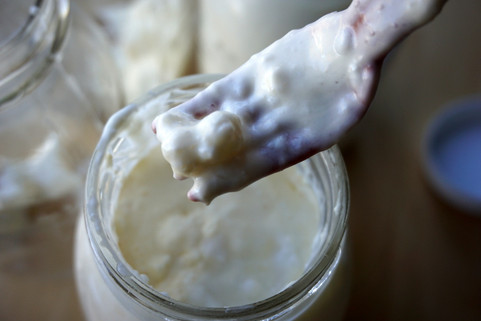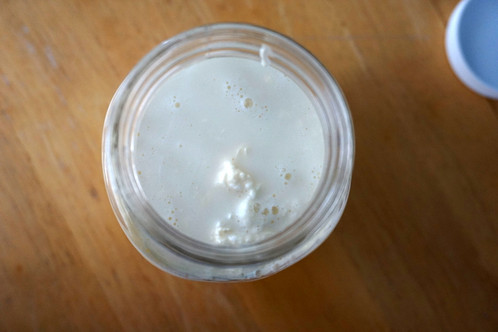Milk kefir is an absolute superfood! And it is hands-down the easiest ferment to make. WIN-WIN!!
What is Milk Kefir?
Milk kefir is a fermented probiotic drink made through culturing milk with kefir "grains". Milk kefir originated in North Caucasus, Eastern Europe and Russia centuries ago, and was even mentioned in Marco Polo's writings. However, milk kefir didn't become well-known in the USA until fairly recently. Milk kefir is a thick and slightly effervescent drink, with a sour, creamy taste.
Kefir grains are not true grains, but are actually symbiotic colonies of bacteria and yeast in a protein and lipid matrix. Kefir grains resemble pieces of cauliflower, and they ferment the milk through breaking down the lactose into lactic acid and other beneficial components.
Kefir is Superior to Yogurt!
Kefir is far superior to yogurt for re-colonizing the gut because it contains more-aggressive strains of beneficial bacteria. Yogurt contains mild probiotics that are more likely to be transient and not make any overall impact on the gut flora.
Kefir contains many more strains of beneficial bacteria than yogurt does, and the aggressive strains of beneficial bacteria in kefir can even kill bad gut bacteria. For instance, kefir has been shown to demonstrate antimicrobial effects against Candida albicans and various pathogenic species of Salmonella, Listeria, Shigella and E. coli, among others [1, 2].

Health Benefits of Kefir
Kefir has been linked to a wide array of health benefits, including:
It is clear that kefir can be a beneficial therapeutic addition to the diet. It's a perfect example of Hippocrates' old maxim" let food be thy medicine, and medicine by thy food."
Homemade vs. Storebought Kefir
Kefir from the store is good for you, but homemade kefir is even better. This is because storebought kefir is made with direct-set powdered kefir cultures, which contain fewer probiotic strains than kefir grains. Powdered kefir cultures generally contain 7 to 12 strains of beneficial bacteria and yeasts, whereas kefir grains contain up to 30 strains of beneficial bacteria and yeasts [1, 2].
Super Easy To Make
Making raw milk kefir couldn't get any easier: All you have to do is put the kefir grains in milk and let the milk sit out on the counter for a day or two until it is done. A batch of kefir can be easily made every 1-2 days, so it is easy to keep up a constant supply.
Which Kefir Grains to Use?
If you know anyone who makes milk kefir, they could probably give you some kefir grains. Since the grains feed on the milk lactose, they are constantly growing. Anyone who makes kefir regularly will end up with lots of extra kefir grains. Kefir grains will allow you to make milk kefir indefinitely without ever having to buy more grains.
If you can't score any milk kefir grains locally, I've been super pleased with these milk kefir grains. They arrive fresh and are not dehydrated, so they start making kefir quicker and easier. I have 'selected' my kefir grains over time to only keep the ones that float on top of the kefir. That way I do not have to strain the kefir in order to remove the grains, but can just scoop them off the top with a fork. When the kefir is finished, they will be floating in the cream at the top of the jar.
Some stores also sell direct-set powdered kefir cultures. These powdered cultures are less ideal because they can only be re-used a few times, and as mentioned above, they contain far fewer strains of beneficial bacteria and yeasts. In contrast, kefir grains can be used over and over indefinitely, and they will continue to make more and more grains.
What Kind of Milk to Use?
Kefir is typically made with cow's milk or goat's milk (but other mammal milk can be used as well, such as sheep or buffalo milk). I use raw milk to make kefir, but pasteurized milk can also be used. When making kefir with raw milk, make sure to use milk that is fairly fresh as older raw milk has too many of the natural milk bacteria which can interfere with the kefir fermentation.
Do NOT use ultra-high-temp (UHT) pasteurized milk for kefir (or for anything else, as it is basically devoid of nutrition and detrimental to health).
How to Make Kefir
Place kefir grains in one quart of milk. This ratio of milk-to-grains works fine if you have at least a few small kefir grains, or any larger kefir grains. If you have a very small amount of kefir grains, it may work best to start with just a pint of milk, until your grains grow larger. People have generally recommended not using metal utensils or materials with kefir, but stainless steel is actually a non-issue for kefir.
Cover the jar with a lid or use a clean towel and secure with a rubber band. I typically use glass mason jars with plastic lids for making and storing kefir.
Leave the jar in a warm place (65-85F degrees) in your home.
After 20-24 hours, check the kefir every 6-12 hours or so. Unless it is particularly warm in your house (or you are using too little milk with your grains), kefir normally takes at least 20-24 hours to form. If it is cool in your house, it may take 48-72 hours for the kefir to be done.
Look for bubbles to know when the kefir is done. Finished kefir will be thick, not runny. With raw milk, there will be bubbles in the cream layer before the rest of the milk is done fermenting, so I usually look for the presence of a few tiny bubbles near the bottom of the jar to know when the kefir is done.
If you see whey separating off from the kefir (usually at the bottom of the jar), the kefir has fermented a little longer than it needed to. It is still totally edible, but will be extra sour so it may be better to use in smoothies or ranch dressing.
Remove the kefir grains, cover the jar of finished kefir with a lid and store in the refrigerator. The kefir grains may be floating right on top of the finished kefir, and able to be easily scooped out with a fork. Otherwise, you might be able to tell where the grains are at the bottom of the jar by looking underneath the jar or looking for bubbles, and then scooping them out with a fork. If that fails, you may need to strain the kefir to find the grains. (I just got rid of the grains that did not float, as straining kefir is much too fussy for me. By using only grains that float, it is very easy to just scoop out the grains off the top of the finished kefir.)
The kefir grains can then be placed in new milk and the process repeated.
In general, it should take no more than ~48 hours to form kefir (or up to 72 hours in the winter when it is cooler). If kefir does not form, remove the grains and start over with fresh milk. If using raw milk, the milk can then be used for smoothies or some other purpose; if using pasteurized milk, it would need to be discarded after sitting on the counter for a few days.

How to Store Milk Kefir Grains
If you won't be making more milk kefir for awhile, it is easy to store the grains in the fridge.
Just put the grains in a small amount of fresh milk and store in the fridge until you are ready to make your next batch. If your grains have been stored in the fridge for more than about 24-48 hours, make sure to use fresh milk when you are ready to start again or else your kefir will be extra sour.
Our Favorite Ways to Consume Milk Kefir
We go through a couple gallons of homemade raw milk kefir per week, and love to use it these ways:
Drink it! My son, husband, and I now actually prefer milk kefir to plain milk. It complements most breakfast foods and desserts well.
Blend it into smoothies, such as this strawberry banana smoothie.
Enjoy it in ranch dressing, which we enjoy on salads, pizza, and veggie sticks.
Do you drink milk kefir? What are you favorite ways to use this superfood?
References
[1] Bourrie, Benjamin C T et al. “The Microbiota and Health Promoting Characteristics of the Fermented Beverage Kefir.” Frontiers in microbiology vol. 7 647. 4 May. 2016, doi:10.3389/fmicb.2016.00647
[2] Prado, Maria R et al. “Milk kefir: composition, microbial cultures, biological activities, and related products.” Frontiers in microbiology vol. 6 1177. 30 Oct. 2015, doi:10.3389/fmicb.2015.01177
[3] Bellikci-Koyu, Ezgi et al. “Effects of Regular Kefir Consumption on Gut Microbiota in Patients with Metabolic Syndrome: A Parallel-Group, Randomized, Controlled Study.” Nutrients vol. 11,9 2089. 4 Sep. 2019, doi:10.3390/nu11092089
[4] Zeynep B. Guzel-Seydim, Tugba Kok-Tas, Annel K. Greene & Atif C. Seydim (2011) "Review: Functional Properties of Kefir", Critical Reviews in Food Science and Nutrition, 51:3, 261-268, doi: 10.1080/10408390903579029
[5] Hsu, Yi-Ju et al. “Kefir Supplementation Modifies Gut Microbiota Composition, Reduces Physical Fatigue, and Improves Exercise Performance in Mice.” Nutrients vol. 10,7 862. 4 Jul. 2018, doi:10.3390/nu10070862
[6] Zeynep B. Guzel-Seydim, Tugba Kok-Tas, Annel K. Greene & Atif C. Seydim (2011) "Review: Functional Properties of Kefir", Critical Reviews in Food Science and Nutrition, 51:3, 261-268, DOI: 10.1080/10408390903579029
[7] de Oliveira Leite, Analy Machado et al. “Microbiological, technological and therapeutic properties of kefir: a natural probiotic beverage.” Brazilian journal of microbiology : [publication of the Brazilian Society for Microbiology] vol. 44,2 341-9. 30 Oct. 2013, doi:10.1590/S1517-83822013000200001
Links to Amazon are affiliate links. If you use these links, your price remains the same but I may earn a small commission. Thanks for supporting this site!
























Comentários